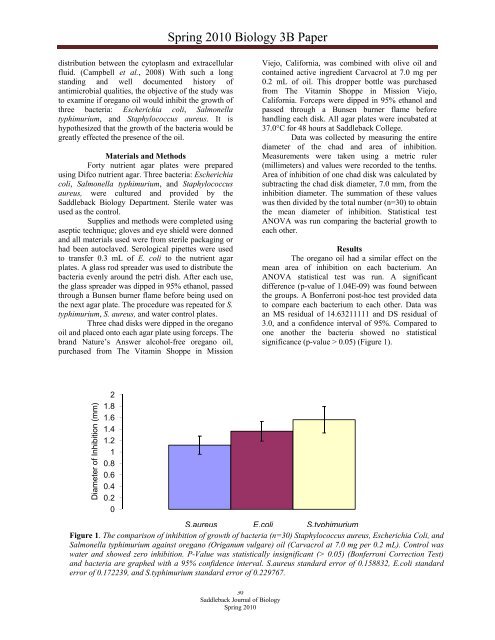Saddleback Journal of Biology - Saddleback College
Saddleback Journal of Biology - Saddleback College
Saddleback Journal of Biology - Saddleback College
You also want an ePaper? Increase the reach of your titles
YUMPU automatically turns print PDFs into web optimized ePapers that Google loves.
Spring 2010 <strong>Biology</strong> 3B Paper<br />
distribution between the cytoplasm and extracellular<br />
fluid. (Campbell et al., 2008) With such a long<br />
standing and well documented history <strong>of</strong><br />
antimicrobial qualities, the objective <strong>of</strong> the study was<br />
to examine if oregano oil would inhibit the growth <strong>of</strong><br />
three bacteria: Escherichia coli, Salmonella<br />
typhimurium, and Staphylococcus aureus. It is<br />
hypothesized that the growth <strong>of</strong> the bacteria would be<br />
greatly effected the presence <strong>of</strong> the oil.<br />
Materials and Methods<br />
Forty nutrient agar plates were prepared<br />
using Difco nutrient agar. Three bacteria: Escherichia<br />
coli, Salmonella typhimurium, and Staphylococcus<br />
aureus, were cultured and provided by the<br />
<strong>Saddleback</strong> <strong>Biology</strong> Department. Sterile water was<br />
used as the control.<br />
Supplies and methods were completed using<br />
aseptic technique; gloves and eye shield were donned<br />
and all materials used were from sterile packaging or<br />
had been autoclaved. Serological pipettes were used<br />
to transfer 0.3 mL <strong>of</strong> E. coli to the nutrient agar<br />
plates. A glass rod spreader was used to distribute the<br />
bacteria evenly around the petri dish. After each use,<br />
the glass spreader was dipped in 95% ethanol, passed<br />
through a Bunsen burner flame before being used on<br />
the next agar plate. The procedure was repeated for S.<br />
typhimurium, S. aureus, and water control plates.<br />
Three chad disks were dipped in the oregano<br />
oil and placed onto each agar plate using forceps. The<br />
brand Nature’s Answer alcohol-free oregano oil,<br />
purchased from The Vitamin Shoppe in Mission<br />
Viejo, California, was combined with olive oil and<br />
contained active ingredient Carvacrol at 7.0 mg per<br />
0.2 mL <strong>of</strong> oil. This dropper bottle was purchased<br />
from The Vitamin Shoppe in Mission Viejo,<br />
California. Forceps were dipped in 95% ethanol and<br />
passed through a Bunsen burner flame before<br />
handling each disk. All agar plates were incubated at<br />
37.0°C for 48 hours at <strong>Saddleback</strong> <strong>College</strong>.<br />
Data was collected by measuring the entire<br />
diameter <strong>of</strong> the chad and area <strong>of</strong> inhibition.<br />
Measurements were taken using a metric ruler<br />
(millimeters) and values were recorded to the tenths.<br />
Area <strong>of</strong> inhibition <strong>of</strong> one chad disk was calculated by<br />
subtracting the chad disk diameter, 7.0 mm, from the<br />
inhibition diameter. The summation <strong>of</strong> these values<br />
was then divided by the total number (n=30) to obtain<br />
the mean diameter <strong>of</strong> inhibition. Statistical test<br />
ANOVA was run comparing the bacterial growth to<br />
each other.<br />
Results<br />
The oregano oil had a similar effect on the<br />
mean area <strong>of</strong> inhibition on each bacterium. An<br />
ANOVA statistical test was run. A significant<br />
difference (p-value <strong>of</strong> 1.04E-09) was found between<br />
the groups. A Bonferroni post-hoc test provided data<br />
to compare each bacterium to each other. Data was<br />
an MS residual <strong>of</strong> 14.63211111 and DS residual <strong>of</strong><br />
3.0, and a confidence interval <strong>of</strong> 95%. Compared to<br />
one another the bacteria showed no statistical<br />
significance (p-value > 0.05) (Figure 1).<br />
Diameter <strong>of</strong> Inhibition (mm)<br />
2<br />
1.8<br />
1.6<br />
1.4<br />
1.2<br />
1<br />
0.8<br />
0.6<br />
0.4<br />
0.2<br />
0<br />
S.aureus E.coli S.typhimurium<br />
Figure 1. The comparison <strong>of</strong> inhibition <strong>of</strong> growth <strong>of</strong> bacteria (n=30) Staphylococcus aureus, Escherichia Coli, and<br />
Salmonella typhimurium against oregano (Origanum vulgare) oil (Carvacrol at 7.0 mg per 0.2 mL). Control was<br />
water and showed zero inhibition. P-Value was statistically insignificant (> 0.05) (Bonferroni Correction Test)<br />
and bacteria are graphed with a 95% confidence interval. S.aureus standard error <strong>of</strong> 0.158832, E.coli standard<br />
error <strong>of</strong> 0.172239, and S.typhimurium standard error <strong>of</strong> 0.229767.<br />
30<br />
<strong>Saddleback</strong> <strong>Journal</strong> <strong>of</strong> <strong>Biology</strong><br />
Spring 2010

















